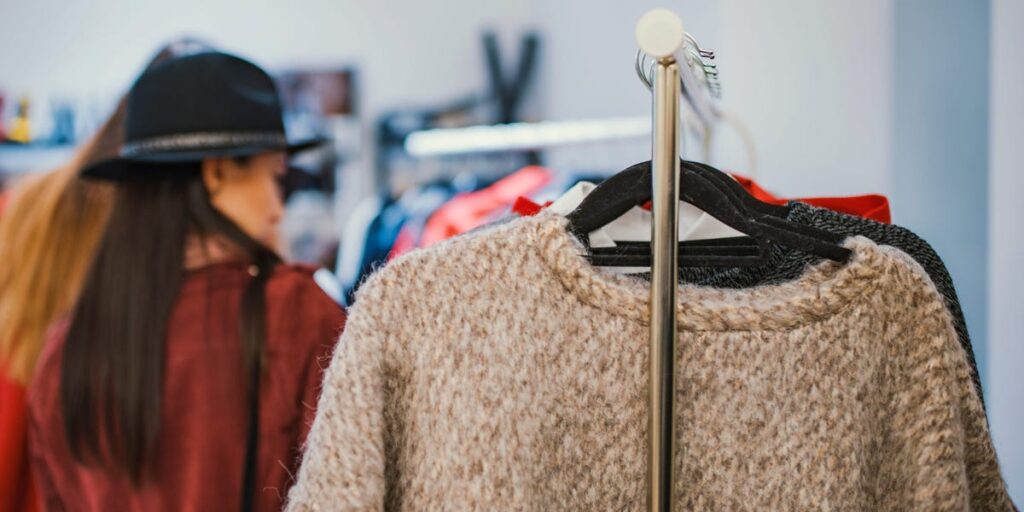When I became pregnant with my first kid back in 2019, I was set on only buying new clothes for her. It had to be clothing made with the Earth in mind and of the highest quality — sustainably-sourced materials and 100% cotton.
My babylist consisted of pricey garments, mimicking that of any momfluencer’s list of newborn must-haves, a point of pride for someone raised on welfare.
I wanted my daughter to have the life and childhood I couldn’t have growing up, and I thought expensive clothing would give her just that. I was wrong.
Growing up, I knew that ‘free’ came with a price: shame
My mother was 16 and my father was 18 when they wed at the courthouse, and, a year later, they had me. Because of their lack of experience and education, we lived paycheck to paycheck and had regular appointments at Social Services or the Health Department.
On rare occasions — like my birthday, Easter, or Christmas — I received a new dress and “church” shoes. I would bathe in the outfit’s new smell, floral patterns, and crisp fabrics, stealing away whiffs of the department store from whence they came and trying on the get-up in a full-length mirror.
As our family grew from three to seven, my siblings and I received less and less new clothing. I don’t remember us complaining much, but I do remember thinking in adolescence how I’d start working as soon as I could, so that I could buy the clothes that I wanted without burdening my parents.
I started working at 14 at a Greek family restaurant across the street from my high school. After my first paycheck, I took myself to the mall and bought a brand new pair of jeans and a T-shirt that were on sale at Hollister.
From that point on, I became unstoppable, working up to four jobs at a time while I pursued undergraduate and graduate degrees. In 2009, I got married and moved away from home to earn a better living. Although it pained me to leave my family behind, I felt powerful knowing that I’d halted the cycle of poverty.
And when I had my kids, I wanted to assuage any mom guilt by keeping my kids out of poverty.
Becoming a mother opened old childhood wounds
When I became a mother at the height of COVID in Manhattan, I hadn’t anticipated the dramatic shift in identity that I felt in postpartum. With every cry, feed, or wake of my baby, buried childhood wounds began to surface, and I realized that I could no longer ignore their existence. I had to confront them in order to be the mother that I wanted to be.
The standards I had set for my baby, my husband, and myself were too high. Over time, I quickly realized the impracticality of buying new clothes, new toys — new everything — for my daughter.
By her first birthday, my mindset had radically shifted. Kids are messy. They destroy their garments from daily play, so my own emotional need to purchase expensive clothing for my child became an absurd and unreasonable habit, particularly as a stay-at-home mother who was no longer an active contributor to our household income.
Painstakingly, I learned what I really needed to do was to work on healing my inner child. This actualization occurred after I gave birth to my second daughter, 20 months after I had my first. It was when I found myself home with two under 2 and what seemed like a never-ending factory line of rolling tasks that I did the hard work of finding the right therapist.
I allowed myself to buy used clothing for my kids
While I set out on my own healing journey, I started my search for gently used clothing and shoes at secondhand stores, just like my mom did when I was a kid.
I discovered local shops that carried the brands that I’d once gawked over via social media ads and began visiting these stores regularly. I’d often find pieces in my daughters’ sizes (or a size or two above) at more than half the price of retail.
My daughters are now 3 and 5, and I still almost exclusively shop at these stores, and even encourage my children’s grandparents to do the same.
Without a doubt, therapy has been pivotal in maintaining my emotional well-being and has helped me become a more clear-headed, less self-critical mother.
I’ve also learned that it’s OK to alter the original plan. It doesn’t mean that I’m a failure of a mother, and it doesn’t mean that my mom was a failure either. It shows that I’m still learning and that my mom was making the best choices she could given her difficult situation.


